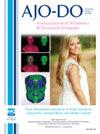Transverse dentoalveolar development in Chinese children and adolescents: A cross-sectional study using revised Andrews’ Element III analysis
IF 2.7
2区 医学
Q1 DENTISTRY, ORAL SURGERY & MEDICINE
American Journal of Orthodontics and Dentofacial Orthopedics
Pub Date : 2025-02-01
DOI:10.1016/j.ajodo.2024.08.015
引用次数: 0
Abstract
Introduction
This study investigated the prevalence of maxillary transverse deficiency (MTD) in Chinese children and adolescents using revised Andrews’ Element III analysis and studied transverse developmental characteristics of the maxillomandibular complex.
Methods
Plaster or digital casts of 794 participants aged 7-18 years were evaluated. MTD was diagnosed when the maxilla-mandible width difference, represented by the decompensated maxillary and mandibular first molars, exceeded 4 mm.
Results
The average prevalence of MTD among patients aged 7-18 years was 31.1%. Patients with MTD exhibited narrower maxillary and/or wider mandibular arches. Strikingly, 32.3% of participants with posterior crossbite because of local crowding or mandibular deviation were not diagnosed with MTD. Dental compensation, such as a greater buccolingual inclination of the first molars, was common in patients with MTD. Transverse growth of the maxillomandibular complex was completed by 17 years old, with the maxilla undergoing greater transverse growth than the mandible. The physiological buccolingual inclination of first molars was observed in patients without MTD. The 95% reference value of the palatal arch width was 31.9-42.3 mm.
Conclusions
The prevalence of MTD is 31.1% among Chinese children and adolescents. However, it is often camouflaged by dental compensation and sagittal discrepancy. The etiology of MTD is uncoordinated width in the maxillomandibular complex, which is not solely attributed to a narrow maxilla but also to an excessively wide mandible. To enhance diagnostic accuracy, individualized measurements of the maxillomandibular complex and a revised dental decompensation formula, rather than posterior crossbite alone, are recommended for transverse diagnosis. A potential presence of MTD is indicated when the palatal arch width is <31.9 mm.
中国儿童和青少年的牙槽骨横向发展:使用修订版安德鲁斯要素 III 分析法进行的横断面研究。
简介:本研究采用修订的安德鲁斯要素三分析法调查了中国儿童和青少年上颌横向缺损(MTD)的患病率,并研究了上颌颌面复合体的横向发育特征:方法: 对 794 名 7-18 岁参与者的石膏或数字石膏进行评估。当上颌与下颌第一磨牙失代偿所代表的上颌-下颌宽度差超过 4 毫米时,即可诊断为 MTD:结果:在 7-18 岁的患者中,MTD 的平均发病率为 31.1%。MTD患者的上颌牙弓较窄和/或下颌牙弓较宽。引人注目的是,32.3%因局部拥挤或下颌偏斜而导致后交叉咬合的患者并未被诊断为MTD。在 MTD 患者中,第一臼齿颊舌向倾斜较大等牙齿代偿现象很常见。上下颌复合体的横向生长在 17 岁时完成,上颌骨的横向生长大于下颌骨。第一磨牙的生理性颊舌向倾斜在无MTD的患者中也可观察到。腭弓宽度的 95% 参考值为 31.9-42.3 mm:结论:在中国儿童和青少年中,MTD的发病率为31.1%。然而,MTD 常被牙齿代偿和矢状不齐所掩盖。MTD的病因是上颌颌面复合体宽度不协调,这不仅归因于上颌骨过窄,也与下颌骨过宽有关。为了提高诊断的准确性,建议在横向诊断时对上颌下颌复合体进行个体化测量,并采用修订后的牙齿分解公式,而不仅仅是后交叉咬合。当腭弓宽度为
本文章由计算机程序翻译,如有差异,请以英文原文为准。
求助全文
约1分钟内获得全文
求助全文
来源期刊
CiteScore
4.80
自引率
13.30%
发文量
432
审稿时长
66 days
期刊介绍:
Published for more than 100 years, the American Journal of Orthodontics and Dentofacial Orthopedics remains the leading orthodontic resource. It is the official publication of the American Association of Orthodontists, its constituent societies, the American Board of Orthodontics, and the College of Diplomates of the American Board of Orthodontics. Each month its readers have access to original peer-reviewed articles that examine all phases of orthodontic treatment. Illustrated throughout, the publication includes tables, color photographs, and statistical data. Coverage includes successful diagnostic procedures, imaging techniques, bracket and archwire materials, extraction and impaction concerns, orthognathic surgery, TMJ disorders, removable appliances, and adult therapy.

 求助内容:
求助内容: 应助结果提醒方式:
应助结果提醒方式:


